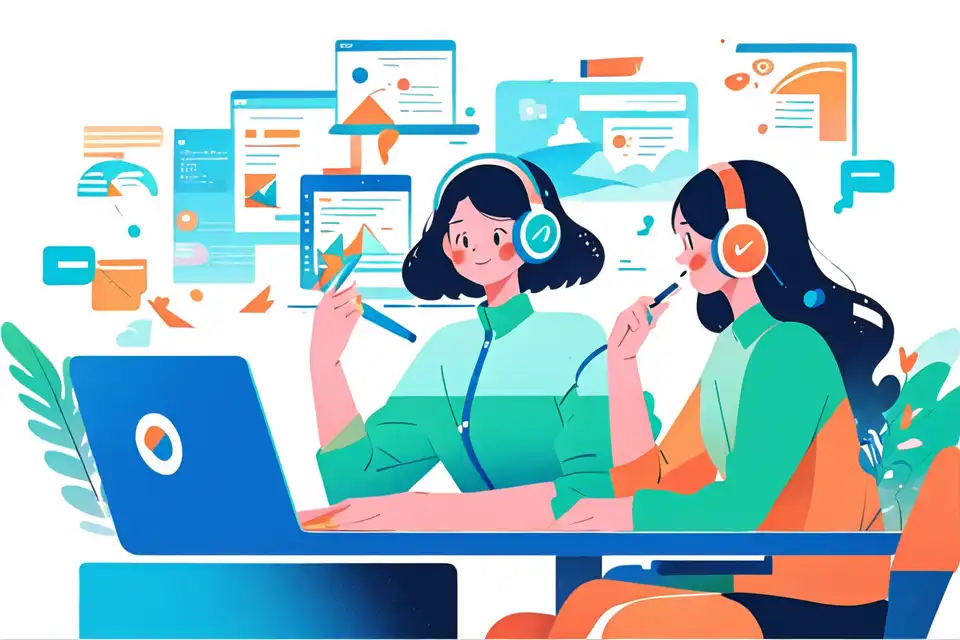Interview Questions for Ux Designers (with Top Questions and Answers)
Mastering the Art of Job Interviews for interview questions for ux designers: Job Interview Examples and Insights
Try Lark for Free
In today's digital landscape, the role of a UX designer is pivotal in shaping seamless and engaging user experiences. To land a position in this competitive field, it's essential not only to possess the necessary skills but also to effectively demonstrate them during the interview process. This article will provide valuable insights into the essential qualities that hiring managers seek in UX designers, how to adequately prepare for the interview, top questions commonly asked during interviews, along with sample answers, do's and don'ts for interview preparation, and frequently asked questions (FAQs) to equip you for success.
What hiring managers look for in a ux designer's role
In the dynamic world of digital products and services, UX designers play a crucial role in ensuring seamless and intuitive user experiences. When hiring for this coveted role, organizations seek individuals who possess a unique blend of creativity, technical expertise, and a deep understanding of user behavior. Let's delve into the key attributes that hiring managers typically look for in a UX designer.
Significance of UX Designers in the Digital Landscape
The demand for UX designers has surged, correlating with the increasing emphasis on user-centric design across industries. Organizations recognize the pivotal role of UX designers in creating products that not only meet user needs but also delight and engage them.
Essential Skills and Qualities Sought by Hiring Managers
- Proficiency in UX design tools such as Adobe XD, Sketch, or Figma
- Strong understanding of interaction design and information architecture
- Ability to conduct user research and translate insights into innovative design solutions
- Excellent communication and collaboration skills within cross-functional teams
- An eye for detail and a strong aesthetic sensibility
The Role of a UX Designer Within the Organizational Structure
UX designers often work collaboratively with product managers, developers, and other stakeholders to craft compelling experiences for end users. They bridge the gap between user needs and business objectives, ensuring that the final product strikes a balance between functionality and user satisfaction.
Key Responsibilities and Expectations of a UX Designer
UX designers are typically responsible for:
- Conducting user research to understand behaviors, needs, and pain points
- Creating wireframes, prototypes, and high-fidelity designs
- Collaborating with stakeholders to iterate and refine design solutions
- Conducting usability testing to gather feedback and insights for improvement
- Ensuring consistency in design language and user interface across digital platforms
Illustrative Examples of Successful UX Design Projects
To contextualize the impact of UX design, consider examples such as:
- The redesign of a mobile application that led to a significant increase in user engagement and retention
- The implementation of a streamlined checkout process on an e-commerce platform, resulting in a notable rise in conversion rates
How to prepare for a ux designer's interview
Securing a UX designer role requires careful preparation and a strategic approach to presenting your skills and experience. Here's a comprehensive guide to help you effectively prepare for the interview process.
Understanding the Company and Its Users
Before stepping into the interview room, take the time to thoroughly research the company's products, services, and target audience. Understand the unique challenges and pain points that the company aims to address through its digital offerings.
Polishing Your Portfolio and Online Presence
Your portfolio is a reflection of your skills and expertise. Ensure that it showcases a diverse range of projects, highlighting your ability to tackle varied design challenges. Additionally, maintain a strong online presence through platforms such as LinkedIn and Behance, reinforcing your commitment to the field.
Crafting Compelling Responses to Behavioral and Technical Interview Questions
Practice articulating your design process, problem-solving abilities, and collaborative approach through mock interviews or self-assessment. Tailor your responses to showcase your adaptability and resilience in navigating diverse design scenarios.
Use Lark for video interviews and candidate tracking.
Top 5 interview questions for ux designers and how you should answer them
The interview process often includes a set of questions aimed at evaluating a UX designer's skills, experience, and fit within the organizational culture. Let's explore five common interview questions and the optimal ways to respond to them.
Question 1: "Can You Walk Us Through Your Design Process?"
Why Does This Question Matter?
Hiring managers seek insights into your approach to problem-solving, ideation, and execution within the design process. They aim to assess your ability to translate user insights into viable design solutions.
What Do They Listen for in Your Answer?
- Clarity in articulating the design process, from initial research to final implementation
- Emphasis on user empathy and iterative design methodologies
- Collaboration with cross-functional teams and stakeholders throughout the process
Sample Answer
During my design process, I start by conducting thorough user research to gain a deep understanding of their needs and pain points. This often involves creating user personas and journey maps to inform the design direction. Following this, I move on to crafting wireframes and prototypes, seeking feedback from both users and stakeholders. Iteration is a central tenet of my design approach, allowing me to refine and validate design solutions before final implementation.
Question 2: "How Do You Approach Designing for Diverse User Demographics?"
Why Does This Question Matter?
This question is aimed at evaluating your capacity to cater to diverse user needs and preferences, ensuring inclusive and accessible design solutions.
What Do They Listen for in Your Answer?
- Consideration of accessibility guidelines and best practices
- Adaptable design solutions that cater to varying demographics
- Incorporation of user feedback and usability testing to validate designs across demographics
Sample Answer
In approaching design for diverse user demographics, I emphasize inclusivity and accessibility throughout the process. This involves conducting thorough research to understand the unique requirements of diverse user groups. I prioritize universal design principles to ensure that all users, irrespective of their demographics, can interact effectively with the product. Furthermore, I regularly leverage usability testing to gather feedback and iterate on design solutions to address the needs of diverse user segments.
Question 3: "Discuss a Particularly Challenging Project and How You Overcame Obstacles."
Why Does This Question Matter?
Hiring managers want to gauge your problem-solving abilities and resilience when faced with complex design challenges. They seek to understand your approach to overcoming obstacles and driving projects to successful completion.
What Do They Listen for in Your Answer?
- Identification of specific design challenges and the strategies employed to address them
- Collaboration with team members and stakeholders to navigate obstacles
- Insights gained from the experience, leading to personal and professional growth
Sample Answer
One particularly challenging project I encountered involved the redesign of a complex data visualization tool. The primary hurdle was distilling vast datasets into a coherent and easily comprehensible format. To address this, I adopted a collaborative approach, regularly seeking input from both the development team and end users. Through iterative prototyping and user feedback, we were able to uncover the most intuitive data visualization methods, ultimately enhancing the tool's usability and value to our users.
Question 4: "Explain a Situation Where You Disagreed with a Team Member. How Did You Handle It?"
Why Does This Question Matter?
This question aims to assess your ability to manage conflicts constructively within a team environment, emphasizing effective communication and resolution strategies.
What Do They Listen for in Your Answer?
- Demonstration of effective communication and conflict resolution skills
- Focus on achieving consensus and maintaining a positive team dynamic
- Reflection on lessons learned and improvements implemented following the disagreement
Sample Answer
In a previous project, a disagreement arose regarding the visual direction for a product feature. Recognizing the importance of aligning on a cohesive design, I initiated a candid discussion with the team member to understand their perspective and communicate mine. We sought common ground by prioritizing user feedback and design best practices. Ultimately, we arrived at a solution that integrated both our insights, leading to a stronger outcome.
Question 5: "What Is Your Approach to Staying Updated with the Latest Industry Trends and Technologies?"
Why Does This Question Matter?
This question assesses your commitment to continual learning and professional development within the rapidly evolving field of UX design.
What Do They Listen for in Your Answer?
- Active engagement with industry conferences, workshops, and design communities
- Pursuit of ongoing education and skill enhancement
- Application of emerging trends and technologies to enhance design solutions
Sample Answer
I proactively stay updated with the latest industry trends and technologies by regularly attending design conferences, participating in webinars, and engaging with design communities. This exposure allows me to gain insights into emerging design methodologies and technologies. Additionally, I actively seek out opportunities for continued education, such as online courses and workshops, enabling me to integrate the latest trends into my design approach.
Do's and don'ts for ux designers interviews
Do's
- Showcase Knowledge of UX Design Principles: Demonstrate a strong understanding of UI/UX principles and their application in your design solutions.
- Exhibit Passion for User-Centered Design: Emphasize the centrality of user needs and preferences in your design process, showcasing empathy and commitment to user-centric solutions.
- Demonstrate Collaborative Skills and Communication: Highlight instances where your effective communication and teamwork contributed to successful design outcomes.
Don'ts
- Overemphasize Individual Contributions: Avoid solely focusing on your own contributions, and instead, underscore the collaborative nature of successful design projects.
- Disregard the Importance of Soft Skills: Acknowledge the significance of soft skills such as empathy, adaptability, and communication within the UX design domain.
- Lack Preparedness for Behavioral Questions: Ensure you are ready to articulate your design process and problem-solving abilities through behavioral questions with concrete examples.
Learn more about Lark x Employment








